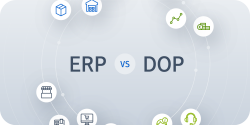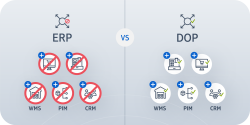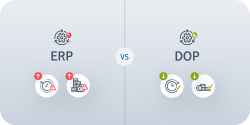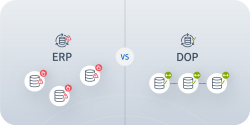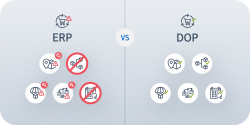ERP vs DOP: Move over ERP, it’s time for DOP!
In 2021, 50% of commerce companies are soon acquiring, upgrading, or planning to work on their digital solutions. Especially ERP systems are critically looked at. That’s because ERP systems are a crucial part of commerce operations. However, they often move too slowly, lack intelligence, and are too complex for the realities and customer expectations of the digital world.
So what to do with an outdated ERP? Choosing and implementing a new one might not be the best choice. Over 50% of implementations fail the first time around. A huge waste of time and money, not to mention the frustrations an ERP implementation will bring.
But is there another option? Does a system that can replace ERPs, and that overcomes general ERP challenges, exist?
The answer is yes. We’d like to introduce you to the Digital Operations Platform:
Digital initiatives fail without the right operational systems and processes, and many enterprise resource planning (ERP) initiatives have failed to deliver on their promises. Today, we see the beginning of a new era of operational systems that are so different that calling them ERP no longer makes sense. We call them the digital operations platform (DOP) – Forrester
What is a DOP and why will it replace ERPs?
A Digital Operations Platform is a central solution that is used to unify and centralize all data-streams related to back-office operations. With a DOP a closed feedback loop is created throughout the business to power better customer and employee experiences.
Similar to ERP’s it becomes the main hub for crucial operations such as order management, supply chain management, customer management, and more. However, DOP’s are much more suited to modern businesses.
Let us show you why it is time to leave ERPs behind and choose a DOP instead.
ERP vs DOP: Flexbility
44% of organizations say their ERP is inflexible
In modern business, operational systems need to be flexible to adapt to changes in the commerce landscape. They must be able to easily change key operational processes, scale up as sales volumes become higher, add new sales channels, and change workflows accordingly.
Also, to accommodate the operations necessary in commerce (such as multichannel order management, inventory management, warehouse management), ERPs need to be able to connect to other systems (OMS, WMS, CRM and more).
Unfortunately, most ERPs are unable to do so adequately, which leads businesses to either change their processes to fit the ERP or customize the ERP which both takes up lots of time and money.
How is a DOP going to fix this?
DOPs Are Designed to be Flexible and Scalable
A DOPs purpose is to bring together all types of data streams, whether from sales channels, WMS, PIM, or CRM. It supports any workflow with these data, unifying them and combining them to allow for any operation, no matter the complexity. Also, as all data streams are managed in one centralized platform, they can easily be adapted.
Scaling your business with a DOP is easy. In contrast to ERPs, its technology is designed to support high volumes of data, including orders and inventory movements. Also, adding new sales channels or third-party software is easy, as they can be added to existing workflows or be configured on the go.
ERP vs DOP: Implementation
Time is money but 74% of ERP projects take longer than expected and 64% of ERP projects go over budget
We’re not going to lie: replacing a legacy ERP is difficult. Replacing a legacy ERP with another ERP however, is a downright nightmare!
By default, an ERP is embedded in many different parts of your business operations. Often custom connections are made between systems, custom workflows are used, and different departments use the ERP in different ways. And a new ERP does not support all these needs out-of-the-box.
This means that before switching to a new system, a lot of time needs to go into creating new custom features, testing whether workflows are correctly configured, educating many different users at once on how to use the new ERP, and so on, and so on. This makes ERP replacement projects long and costly.
How is a DOP going to fix this?
Agile Implementations
The good thing about a DOP is that it can be introduced gradually. A DOP unifies data streams, but that does not mean that all data streams need to be implemented at once. When installing a DOP, the most crucial systems and data will be connected first, to support certain operations only. The DOP can start managing your operations, while new components are added on the go.
It can even work together with your old ERP allowing you to set up all operations correctly before completely moving them to the DOP.
This means you can be a lot more agile in planning time, costs, and educating your staff.
ERP vs DOP: Automation
92% still need to undertake some form of manual actions to share data between platforms
Many ERPs are incapable of integrating with third-party software that is needed in commerce (think of OMS, WMS, CRM, BI, and more). This means that operational workflows can only be facilitated through manual data transfers between systems. Manual data transfers are a pain when it comes to operational management. It takes up a lot of time and gives way to errors. Almost half of all businesses use spreadsheets to transfer and analyze data that have been pulled from the ERP manually.
Next to manual errors, these practices lead to the creation of data silos, dispersing data throughout the company. When different teams are working with different data sources, they are missing out on opportunities to combine data and optimize processes accordingly.
How is a DOP going to fix this?
Full data automation
A DOP makes sure all data streams are unified, and available for automation. This means that data can be used to set up any operational commerce workflow that’s possible with these data. Manual data transfers become a thing of the past, and so are manual errors!
Also, your teams no longer have to work with excel sheets and can access any type of data they need to improve operational processes.
ERP vs DOP: Commerce
ERPs are not made for Commerce: just 4% of ERPs support Omnichannel
An often heard struggle is based on the fact that many ERPs are not built for commerce. ERPs can be used in many different types of businesses. However, commerce asks for many specific operations because of customer demands, multi-channel sales, and multi-inventory locations.
Operations that need to be supported may include:
- Buy online pick up in-store
- Split shipments
- Drop shipment
- Inventory balancing
- Subscriptions
Unfortunately, these are not often supported by ERPs out of the box. These features either need to be custom developed or managed by hand. What’s even worse, in some cases, the operations mentioned above cannot be supported at all leaving merchants no option but to switch to another system.
How is a DOP going to fix this?
Built for Commerce Workflows
Marello DOP is a digital operations platform that is built for commerce specifically. It supports all processes needed for great commerce experiences. With a DOP you can install any workflow you want, for any type of commerce operation. Some examples:
- Set up multiple pick-up points for your products, whether in-store, at a post office, or at a pick-up station.
- Send orders from multiple locations, such as warehouses, suppliers (drop shipment), and brick-and-mortar stores.
- Connect to your suppliers and dropship items to customers.
- Always have enough inventory in stock, balance inventory between sales channels according to demand.
- Got subscription-based products? No problem! Send them at fixed times and set up periodic payments.
There are many more examples in which a DOP offers commerce features out-of-the-box that would not be possible with an ERP.
Conclusion: is DOP the new ERP?
First of all, a DOP should not be seen as an ERP. ERPs cope with many problems, as mentioned above. DOPs have not inherited these problems. Instead, they are built to overcome them. Therefore, a DOP should be seen as a great alternative for an ERP.
Secondly, it is good to know that DOPs do not offer all the same features that an ERP offers. Often, features such as accounting, HR, and manufacturing are not included. However, due to the flexible architecture, these can easily be added (best of breed approach). We’ll explain this in a future blog.
So should you choose a DOP over a new ERP? Absolutely! It will save you time, money, and frustrations! Also, it will give you many more benefits including a better manageable platform, no more data silos, and happier customers!
About Marello
Marello is a DOP for commerce. A powerful platform to accelerate operations across channels. Manage any sales channel while unifying essential back-office operations. Want to know how it could benefit your business? We’d be happy to show you how.
Back to blog